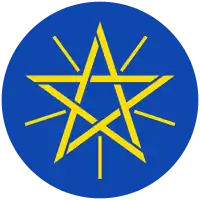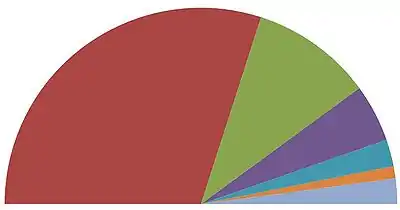Elections in Ethiopia
At the federal level, Ethiopia elects a legislature. The Federal Parliamentary Assembly has two chambers: the Council of People's Representatives (Yehizbtewekayoch Mekir Bet) with not more than 550 members as per the constitution but actually nearly 547 members, elected for five-year terms in single-seat constituencies; and the Council of the Federation (Yefedereshn Mekir Bet) with 117 members, one each from the 22 minority nationalities, and one from each professional sector of its remaining nationalities, designated by the regional councils, which may elect them themselves or through popular elections.
 |
|---|
| This article is part of a series on the politics and government of Ethiopia |
Ethiopia is a dominant-party state in that a coalition, the Prosperity Party, dominates politics. Opposition parties are allowed, and while hypothetically capable of winning an election according to the Ethiopian political system, in practice the party is incapable of losing an election.
Elections were first held in Ethiopia under the provisions of the current constitution in June 1994 to elect the membership of local governments; general elections have since been held in 1995, 2000, 2005, 2010 and 2015.
1995 general election
General elections were held in Ethiopia on 7 and 18 May 1995 for seats in its Council of People's Representatives; elections in the Afar, Somali, and Harari Regions were delayed until 28 June to assign experienced personnel who could solve possible conflicts and irregularities. Although this was the first multi-party election in Ethiopia, several opposition parties boycotted the election.[1] The parties boycotting the election included the All-Amhara People's Organization, Council of Alternative Forces for Peace and Democracy in Ethiopia, and Ethiopian Democratic Unity Party.[2]
2000 general election
Ethiopia held general elections on 14 May and 31 August 2000 for seats in both its national House of Peoples' Representatives and several regional government councils. Although several opposition parties boycotted the election, 17 parties including the All-Amhara People's Organization, the Southern Ethiopia Peoples' Democratic Coalition (SEPDC), and the Oromo National Congress did participate.[3]
In round one, held on 14 May, there were 20,252,000 registered voters, of whom 90% voted.[4] the Ethiopian People's Revolutionary Democratic Front (EPRDF) member parties captured 481 of the 547 seats in the national election. Independents won 13 seats and other parties won 53.[5] Six of the seven constituencies in the Hadiya Zone where elections were run, were won by the Hadiya National Democratic Organization led by Beyene Petros.[6]
The second round was held on August 31 for the Somali Region alone, with 23 seats reserved for the region in the House of Peoples' Representatives and the 168 seats in the State Council. About 75% of the 1.15 million registered voters in the Region cast ballots. Announced results gave 19 of the seats to the SPDP, and the remaining four to independent candidates.[4]
In the Regional elections, either the EPRDF or one of its member parties won the election except in Afar (where the Afar National Democratic Party won 84 of the 87 local seats), Benishangul-Gumuz (where the Benishangul Gumuz People's Democratic Unity Front won 71 of the 80 seats), Gambela (where the Gambela People's Democratic Front won 40 of the 53 seats), and Somali (where the Somali People's Democratic Party won 150 of the 168 seats).[7]
According to observers organized by Ethiopian Human Rights Council, local U.N. staff, diplomatic missions, political parties, and domestic non-governmental organizations, both the general and the regional elections that year were generally free and fair in most areas; however, serious election irregularities occurred in the Southern Nations, Nationalities and Peoples' Region (SNNPR), particularly in the Hadiya Zone.[3]
2005 general election

Red: EPRDF
Green: CUD
Purple: UEDF
Dark blue: SPDP
Orange: OFDM
Light blue: Others
Parliamentary elections took place on May 15, 2005, with a reported 90% turnout. Human Rights Watch has accused the Ethiopian government of stifling political dissent and criticism in Oromia, Ethiopia's most populous region. The government has denied these allegations, and cited the occurrence of an opposition rally attended by 250,000 people on May 8 as an example of political freedom in the country.
Provisional results were scheduled to be announced on May 21, and official results June 8; however, due to hundreds of claims of election irregularities from all political parties involved, the provisional results were delayed until June 8 to allow the complaints to be fully investigated. On August 9, official results were released, acknowledging that the ruling EPRDF had won 296 of the total 524 seats - about 56 percent - enabling it to form a government. However, Berhanu Nega, vice-chairman of the Coalition for Unity and Democracy, had criticized the process, claiming that "The investigation process was a complete failure. Our representatives and witnesses have been harassed, threatened, barred and killed upon their return from the hearings."[8] Repeat elections were scheduled for August 21 in 31 areas where either irregularities were reported or results were challenged. Additionally, general elections in the Somali Region were held on August 21.
On September 5, the National Election Board of Ethiopia released its final results, in which the EPRDF retained its control of the government with 327 seats and opposition parties won 174 seats.[9]
2010 General election
A parliamentary election took place on 23 May 2010.[10]
As of 25 May 2010, preliminary election results indicated that the ruling EPRDF party had won 499 of the 536 seats in parliament.[11] The provisional results indicated the EPRDF had won a landslide victory in 9 of the 11 regions and cities.[12] 90% of eligible voters participated the election.[13] Chief European Union (EU) observer Thijs Berman reported that the elections were "peaceful and well organised", but noted an "uneven playing field" and criticized the use of state resources in the EPRDF campaign.[11][12] The EU received numerous reports of intimidation and harassment, but indicated that this did not necessarily affect the outcome of the elections.[11]
The eight-party Medrek coalition won only a single seat in the capital Addis Ababa.[11] Medrek had expected better results in the Oromia Region.[11] Medrek leader Merera Gudina rejected the election results as being "completely fraudulent" and indicated that the coalition is considering what action to take.[11] Human Rights Watch had condemned the election as "multi-party theatre staged by a single party state".[10] Election and government officials have denied such charges.[11][14] Opposition leaders have claimed that their supporters have been subject to harassment and beatings.[15] In March 2010, an opposition politician was stabbed to death, but the government blamed the killing on a personal dispute.[15] A Wall Street Journal article suggests that Medrek had spent much of its energy on coalition-building.[15] International reporters have given the election wide media coverage.
African Union (AU) election observers reported that the election was completely "free and fair" and met all AU election standards.[16] In spite of the opposition's objections, the AU stated that the election "reflected voters' will."[14] The AU observers also reported that opposition party observers were present in most of the polling stations that the AU observed, and found no evidence to support the opposition's charges of pre-election intimidation.[16] At the same time, chief AU observer and former President of Botswana Ketumile Masire noted that "the AU were unable to observe the pre-election period. The participating parties expressed dissatisfaction with the pre-election period. They did not have freedom to campaign. We had no way of verifying the allegations."[16] Masire said that the National Election Board of Ethiopia (NEBE) handled the election in a professional manner and did not interfere with the electoral materials.[16]
Prime Minister Meles Zenawi attributed the election results to the EPRDF's past performance, in particular citing the country's economic growth.[11] According to the International Monetary Fund, Ethiopia's economy grew 9.9% in 2009 and was expected to grow 7% in 2010.[15] Some analysts suggest that the result is a combination of the EPRDF's performance along with state-sponsored intimidation of the opposition.[10]
On 21 June 2010, the NEBE released the final election results, which confirmed the preliminary results from the previous month.[17] The EPRDF won 499 of the 547 available parliamentary seats, opposition or independent candidates won two seats, and EPRDF-allied parties won the remaining seats.[18] Additionally, the EPRDF won all but one of 1,904 council seats in regional elections.[18] The opposition had filed appeals with the election board and the Ethiopian Supreme Court, but both appeals were rejected.[18] On July 20, the Court of Cassation, Ethiopia's highest court, rejected the opposition's final appeal.[19]
2015 general election
Parliamentary elections were held in Ethiopia on 24 May 2015.[20] The result was a victory for the ruling EPRDF, which won 500 of the 547 seats. Allies of the EPRDF won the remaining seats.[21]
2020 general election
The members of the Council of Peoples' Representatives are elected in single-member constituencies for a five-year term. 22 constituencies are reserved for recognized nationalities.
See also
References
- "Monthly Situation Report for Ethiopia: May 1995" UNDP-EUE (accessed 19 January 2009)
- "Elections in Ethiopia: (f) Election 1995" Archived 2009-04-08 at the Wayback Machine, EPRDF website (accessed 29 May 2009)
- "Ethiopia: Country Reports on Human Rights Practices", Bureau of Democracy, Human Rights, and Labor, US State Department (accessed 9 July 2009)
- Ethiopia Parliamentary Chamber: Elections held in 2000, PARLINE database (accessed 20 October 2009)
- African Elections Database
- Sarah Vaughan, "Ethnicity and Power in Ethiopia" Archived August 13, 2011, at the Wayback Machine (University of Edinburgh: Ph.D. Thesis, 2003), p. 196 n. 195
- 14 May and 31 August 2000 Regional State Council Elections in Ethiopia
- http://www.irinnews.org/report.asp?ReportID=48533&SelectRegion=Horn_of_Africa&SelectCountry=ETHIOPIA
- http://www.irinnews.org/report.asp?ReportID=48905&SelectRegion=Horn_of_Africa&SelectCountry=ETHIOPIA
- "Meles Zenawi's party 'heads for Ethiopia election win'". BBC. BBC News. 24 May 2010. Retrieved 25 May 2010.
- "EU observers say Ethiopia election 'falls short'". BBC. BBC News. 25 May 2010. Retrieved 25 May 2010.
- "EU monitors slam Ethiopia polls". Al Jazeera English. 25 May 2010. Retrieved 25 May 2010.
- McConnell, Tristan (25 May 2010). "Western ally wins landslide in Ethiopia amid vote rigging claims". The Times. Retrieved 24 May 2010.
- "Ethiopian polls reflect people's will: AU monitors". Google News. AFP. 2010-05-27. Retrieved 05-28. Check date values in:
|access-date=(help) - Childress, Sarah (22 May 2010). "Critics Stifled in Ethiopia". The Wall Street Journal. Dow Jones & Company, Inc. Retrieved 25 May 2010.
- "African Union observers say Ethiopian elections meet African standards". Afrique en ligne. PanaPress. 2010-05-27. Archived from the original on 2010-05-31. Retrieved 05-27. Check date values in:
|access-date=(help) - "Ethiopia: ruling party landslide confirmed". Google News. AP. 2010-06-21. Retrieved 2010-06-21.
- "Ethiopia ruling party, allies win 99% of vote: result". Google News. AFP. 2010-06-21. Retrieved 2010-06-21.
- Malone, Barry (July 20, 2010). "Ethiopia court rejects final poll result challenge". Google News. Retrieved July 20, 2010.
- "African election calendar 2015". Electoral Institute for Sustainable Democracy in Africa. 2015. Archived from the original on 27 February 2015. Retrieved 26 February 2015.
- Ethiopia's ruling party wins by landslide in general election The Guardian, 22 June 2015
External links
- National Electoral Board of Ethiopia Official Website
- Adam Carr's Election Archive
- African Elections Database
- "Rights group accuses gov't of suppressing opposition" - UN IRIN News
- International Herald Tribune Election Coverage
- Ruling party named winner in final result of disputed poll, IRIN, 5 September 2005
- BBC 2010 election report (Audio)